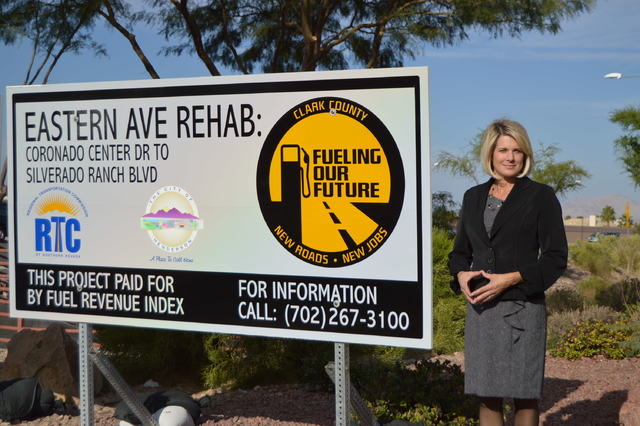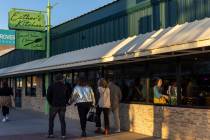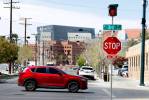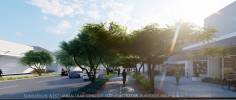EXECUTIVE SNAPSHOT: Tina Quigley, Regional Transportation Commission
Tina Quigley, general manager of the Regional Transportation Commission of Southern Nevada, grew up in Petaluma, Calif., and earned her Bachelor of Science degree in aviation business and planning from Embry Riddle Aeronautical University in Prescott, Ariz.
She’s a trained private pilot and her career in Las Vegas started at McCarran International Airport where she was an intern alongside Jacob Snow. Snow went on to lead the RTC, which operates bus services and handles transit planning.
She became assistant director of planning and construction for the Clark County Aviation Department before Snow hired her as deputy general manager at RTC. She took over from Snow in 2012 when he left to become Henderson city manager.
Q. Since taking over, what changes and improvements have you implemented and what would you consider your biggest success?
For me, it’s a collection of successes. Working with our community partners to get fuel revenue indexing approved for Clark County ranks high. We recently added a new route in the southwest valley – Route 120. For our growing number of older and disabled riders, we recently broke ground on a mobility training center. We also recently increased frequency on our transit routes. In addition, several transit routes will be rerouted or modified to improve service to our riders.
Q. You had an influence in implementing the fuel index, which took effect this year. How does that serve the people of Las Vegas? How many jobs will it create?
Revenues from the motor vehicles fuel tax had been static for nearly 20 years while the cost of construction continued to rise. Fuel revenue indexing is a broad-based community initiative that ties the gas tax to inflation to help fund critically needed transportation projects and creates thousands of jobs in Southern Nevada.
In fact, fuel revenue indexing will yield nearly $700 million of revenue that will fund 199 projects and create approximately 9,000 jobs through 2016.
Without fuel revenue indexing, the RTC was forecasting only $22.4 million a year over the next 10 years in available funds for street and highway projects, which equates to building one interchange per year, one mile of roadway per year in each jurisdiction, or one beltway segment without bridges per year.
By the end of this year, we will have 70 percent of the 199 planned FRI projects either in the design phase or under construction. We have issued 64 contracts for improvement projects valued at $153 million. On the employment front, 2,000 new jobs have been created thus far; and 43 small, minority and women-owned businesses have been engaged in these projects.
Q. Which major areas of traffic congestion are the top priorities at the RTC? How much of that would not be accomplished if not for the fuel index, which is estimated to cost an average motorist a dime a day?
Flamingo Road connects dense residential areas to high-traffic commercial areas … the busiest residential route in the system … FRI funding (has made possible) this 14-mile project that will add dedicated transit lanes and new transit shelters, upgrade traffic signals, and improve pedestrian crossings. Construction will be underway in 2015.
And thanks to fuel revenue indexing, the RTC is constructing approximately 12 miles of new freeway around the southern and eastern perimeter of Boulder City from U.S. (Highway) 95 to U.S. (Highway) 93… The Boulder City Bypass and (Interstate) 11 will relieve traffic congestion, improve safety and enhance travel and commerce between Arizona and Nevada.
FRI is funding the design of improvements along the integral north-south Maryland Parkway corridor that links the airport and UNLV to downtown and beyond. In addition to vehicular traffic, it’s also a high-traffic transit corridor, carrying more than 9,500 passengers per day via direct connections to four of the valley’s busiest routes.
Q. With private companies attempting to enter the market, do you feel the RTC can stay competitive or will privatization ultimately become realty?
A. The Las Vegas Valley spans 600 square miles and has thousands of riders on its roads and buses every day. In addition, it welcomes millions of visitors every year. We are seeing private companies jumping into the transportation arena to provide a unique experience to residents and employees. They are looking to create an environment where you don’t need your own vehicle, and people have the opportunity to use the transportation mode that best fits their needs. We don’t think these concepts are threats to public transit. Similar to taxis, the monorail, tour operators, and other transportation providers, they are a complement to what we offer. We do not have the capacity, as a public transit system, to handle the number of visitors, residents, commuters, and other travelers that require transportation. Providing options and making the travel experience a pleasant one, regardless of the mode, is essential to our economic success.




























